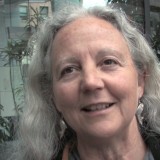I am a biologist and resident of a tiny coastal community on the coast of British Columbia.
When salmon farms arrived I believed the government promotion that itwould be good for my community.
But now that the industry has surrounded us with 27 huge Norwegian
salmon feedlots, there are only 8 people left, the First Nations oppose the
industry, our school is closed, we have the sea lice epidemics, mounds of waste
only bacteria can grow on, toxic algae blooms and zero jobs in the industry. We
learned at the Cohen Inquiry that the federal government has offered to sell
this Norwegian industry to us, the people of Canada. My town was based on wild
salmon through fishing, tourism and the arts. As the wild salmon went so we
went. We did not accept the low paying jobs as reward for allowing this
industry to destroy our coast.
Video from recent Alexandra Morton event in Vancouver – story continues below
Salmon feedlots break the natural laws unleashing bacteria,
viruses and sea lice. My lawyer, Greg McDade, questioned Dr. Laura Richards,
Director General of Science Pacific Region about the 2009 sockeye crash at the
Cohen Inquiry. We learned a briefing note sent to the Minister of Fisheries
stated that a virus is one of the leading suspected causes of the 2009 sockeye
collapse. We also learned DFO
muzzled their own scientist who made this discovery, Dr. Kristi Miller. Salmon
Leukemia virus is a retro virus like HIV. DFO never told the public and left us
to blame fishermen. They also refused to test the farm salmon in an
effort to find out where this virus is coming from.
Salmon farming has harmed wild salmon everywhere they
operate (Ford and Myers, 2008). Canada has already destroyed one earth’s
greatest natural food supplies, the North Atlantic cod, by muzzling their
scientists. Fisheries and Ocean Canada blindly adhered to bad policy kicking the
cod and the east coast economy over the cliff. Immediately after, the Hibernia
oils wells went onto the Grand Banks. Canada traded food security for oil, the
future for short-term gain for the corporate world. No one in DFO was held
accountable and there is every indication that they are doing this again in BC.
I am unwilling to accept our fate as victim of another bad,
misguided policy favouring industry over our communities. As soon as oil prices rise too
far the Norwegian salmon feedlot industry will not be able to afford shipping
ground up fish from Chile to feed their Atlantic salmon here in the Pacific.
They will walk away and we will be sitting like fools with viral epidemics and
piles of manure smothering a once productive seafloor.
All too often people feel helpless. Democracy is slipping
away under the crush of the global economy.We need to wake up right now and step into the process of
how we form governments.Members
of Parliament are our agents, nothing more. Eighty-five percent of British Columbians consider
wild salmon an icon; they bring in over $2 billion a year in wilderness tourism
and fishing, they are an essential bloodstream carrying nutrients to our
forests, they are food security. We want them and our political agents have no
business hiding the truth about them from us. It is time to elect people who will stand by us and defend
our rights and resources.
For these reasons I left home April 13th to go door-to-door
to as many federal candidate campaign offices as possible to get them on record: Do you support wild salmon, would you
protect them by removing salmon feedlots from BC waters, would they protect the
aquaculture workers by supporting land-based aquaculture farming species that
are more sustainable, lower on the food chain than salmon?
I have been down Vancouver Island to Nanaimo, across the
ridings of Vancouver, through Chilliwack to Kamloops, Enderby, Salmon Arm,
Mission. I will be continuing through the lower mainland and southern Vancouver
Island. It has been a fascinating
exploration. I am a biologist with very little political experience and I am on
a steep learning curve.
Here is what I have found out:
The Greens have
some candidates that are very impressive such as, Adriane Carr (Vancouver
Central) and Elizabeth May (Saanich – Gulf Islands). Sue Moen, (Vancouver
Island North) really tells it like she sees it, but is not electable. Some Greens should get out of the way
as they are not serious about winning. Both Carr and May strongly support
wild salmon.They would transition
workers in the industry to land-based aquaculture. I think Carr and May
would go a long way to bring balance to any government.
The Liberals
seemed uncertain of their position, with many candidates remaining silent, but
on April 18 Micheal Ignatieff said, “if fish farms are harming wild salmon
we’ve got to stop it, put it on land or stop it all together.” This is a much
stronger statement than the one made by Mike Holland (Vancouver Island-North)
who said, “We need to get the
science done to understand just what the relationship and impact is, and we
need to be prepared to go where the science takes us. If that takes us to
closed-containment only I support that, but I want the science first. I’m not
prepared to mandate a timeline at this stage.”I think Liberal Renee Heatherington (Saanich-Gulf
Islands) may be pushing her party
to establish a policy on this.
The Conservatives
avoided me, until April 18 when MP Cathy MacLeod accepted our request to meet
in Kamloops.I was really looking
forward to hearing the Conservative position, but as we sat down she said she
could only listen and not give a position. Senator Nancy Greene joined us.I have met Nancy before and know she is
a strong wild salmon supporter.MacLeod’s attitude shifted during the meeting. I think she wanted to see
me as a nut, but as I outlined how the federal government has been hiding a
virus in the sockeye, I saw a change in her and she did say the Conservatives
are awaiting the Cohen decision. This is really not good enough.I have seen three major government
reviews on salmon farming entirely ignored by the provincial and federal
governments. The Cohen Inquiry is not a fish farm review, even if it finds
impact on the sockeye it is not mandated to do a thorough salmon farm
investigation.There is more than
enough evidence of harm to invoke the Precautionary Principle, which Canada
says it supports.
Conservative candidate John Duncan (Vancouver Island-North) told constituents in
Port McNeill that he supports continued salmon farming.At an All-Candidates meeting in Courtenay, Duncan’s seat was
empty – people call him “Mr. Invisible.”
Many of the Conservative offices are
very hard to find, and many people have told me the Conservatives do not attend the
All-Candidate meetings. Paul Forseth’s
(Burnaby–New Westminster) people didn’t want us to take pictures of their
office, saying it was private property. Colin Mayes’ campaign office address is
not on the internet – there is no website. His riding includes the Adams River,
one of earth’s biggest wild salmon runs. The people of Chilliwack-Fraser Canyon
are not pleased that Conservative MP Chuck Strahl just handed the candidacy to
his son Mark. The Conservatives get a thumbs down from me.
The NDP offices
are full of volunteers, people heading out the door with signs, tables of
coffee and snacks as no one has time to go home. Ronna-Rae Leonard (Vancouver
Island-North) is in full support of the people who make a living with wild
salmon, such as the wilderness tourism industry. But she says she is also
concerned with the people directly employed by the salmon farms. Thus she
supports building the infrastructure for a permanent land-based aquaculture
industry. Zeni Maartman (Nanaimo-Alberni) is a dynamo full of passion, energy
and deep commitment to both wild salmon and her riding. Don Davies, Vancouver-Kingsway met with
us and is a man of action, compassion and understanding, in strong support of
wild salmon. Fin Donnelly (New
Westminster-Coquitlam-Port Moody) joined me on the Paddle for Wild salmon
last fall, and is a hero to the wild salmon people province-wide. He tabled a
private member’s bill calling for removal of salmon farms onto land to protect
wild salmon and preserve jobs. Peter Julian (Burnaby-New Westminster) has
been involved with protecting wild salmon for a longtime.Denise Savoie (Victoria), Nathan Cullen
(Skeena-Bulkley Valley), and Jean Crowder (Nanaimo-Cowichan) have also supported wild salmon very
strongly through their careers. Cullen helped protect the North Coast from the
expansion of salmon feedlots into the mouth of the Skeena River. I am hoping the
NDP will become stronger in their platform to remove salmon farms from BC
waters.
Please follow what the politicians are saying at
VoteSalmon.ca
zzz


